Isotopic Constraints On Lightning As A Source Of Fixed Nitrogen In Earth’s Early Biosphere

Bioavailable nitrogen is thought to be a requirement for the origin and sustenance of life. Before the onset of biological nitrogen fixation, abiotic pathways to fix atmospheric N2 must have been prominent to provide bioavailable nitrogen to Earth’s earliest ecosystems.
Bioavailable nitrogen is thought to be a requirement for the origin and sustenance of life. Before the onset of biological nitrogen fixation, abiotic pathways to fix atmospheric N2 must have been prominent to provide bioavailable nitrogen to Earth’s earliest ecosystems.
Lightning has been shown to produce fixed nitrogen as nitrite and nitrate in both modern atmospheres dominated by N2 and O2 and atmospheres dominated by N2 and CO2 analogous to the Archaean Earth. However, a better understanding of the isotopic fingerprints of lightning-generated fixed nitrogen is needed to assess the role of this process on the early Earth.
Here, we present results from spark discharge experiments in N2-CO2 and N2-O2 gas mixtures. Our experiments suggest that lightning-driven nitrogen fixation may have been similarly efficient in the Archaean atmosphere, compared to modern times. Measurements of the isotopic ratio {\delta}15N of the discharge-produced nitrite and nitrate in solution show very low values of -6 to -15 permil after equilibration with the gas phase with a calculated endmember composition of -17 permil.
These results are much lower than most {\delta}15N values documented from the sedimentary rock record, which supports the development of biological nitrogen fixation earlier than 3.2 Ga. However, some Paleoarchean records (3.7 Ga) may be consistent with lightning-derived nitrogen input, highlighting the potential role of this process for the earliest ecosystems.
Patrick Barth, Eva E. Stüeken, Christiane Helling, Lukas Rossmanith, Yuqian Peng, Wendell Walters, Mark Claire
Comments: Accepted manuscript. Version of record published in Nature Geoscience. 29 pages (main text, methods, supplementary material), 5 figures + 4 supplementary figures
Subjects: Geophysics (physics.geo-ph); Earth and Planetary Astrophysics (astro-ph.EP); Instrumentation and Methods for Astrophysics (astro-ph.IM); High Energy Physics – Experiment (hep-ex)
Cite as: arXiv:2305.13345 [physics.geo-ph] (or arXiv:2305.13345v1 [physics.geo-ph] for this version)
Related DOI:
https://doi.org/10.1038/s41561-023-01187-2
Focus to learn more
Submission history
From: Patrick Barth
[v1] Mon, 22 May 2023 09:51:14 UTC (612 KB)
https://arxiv.org/abs/2305.13345
Astrobiology








